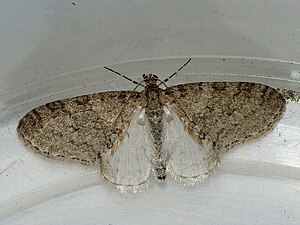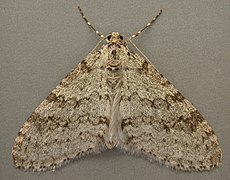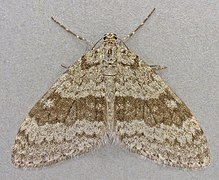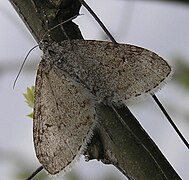Light gray rag tensioner
| Light gray rag tensioner | ||||||||||||
|---|---|---|---|---|---|---|---|---|---|---|---|---|

Light gray lobes ( Trichopteryx carpinata ) |
||||||||||||
| Systematics | ||||||||||||
|
||||||||||||
| Scientific name | ||||||||||||
| Trichopteryx carpinata | ||||||||||||
| ( Borkhausen , 1794) |
The light gray lobes ( Trichopteryx carpinata , syn .: Geometra lobulata ) is a butterfly from the family of the spanners (Geometridae). The species name is derived from a food of the caterpillars , the hornbeam ( Carpinus ).
features
butterfly
The moths reach a wingspan of 26 to 34 millimeters. There is no sexual dimorphism between the sexes in terms of color , but only the males show a rudimentary third pair of wings, the so-called root lobes. The fore wing color varies on the upper side from light brown to light gray to black gray. Either a weak dark marbling or a more or less strongly developed dark band markings can be recognized as wing markings. Small black-brown dots stand out in front of the hem. The upper side of the hind wing is colored whitish, shows a small dark discoidal spot , two indistinct gray transverse lines and is provided with silky white fringes. The very small, whitish-gray third pair of wings, known as the root lobe, arises at the roots of the hind wings.
Color variations of the moths
Caterpillar
Adult caterpillars are grass-green in color, show a yellow or whitish side stripe, also colored segment incisions and a double anal tip.
Doll
The doll is reddish brown in color, shows a double point on the cremaster and greenish wing sheaths.
Similar species
- The gray lobes ( Lobophora halterata ) differs through a blackish basal region on the upper fore wing and in the males through significantly larger root lobes.
- The dashed flap tensioner ( Trichopteryx polycommata ) differs by a rust-brown colored transverse band on the upper side of the forewing .
distribution and habitat
The distribution area of the light gray moth stretches from East Asia through the temperate zone to Europe. The species is also found in the British Isles . The main habitat are mixed and riparian forests. In the Alps it rises to heights of 1,600 meters.
Way of life
The moths are nocturnal and fly in one generation from late March to late May. They visit blooming pussy willows for food . At night they appear on artificial light sources . The caterpillars feed on the leaves of poplar ( Populus ), birch ( Betula ), willow ( Salix ) or hornbeam species ( Carpinus ). The species overwinters in the pupal stage .
Individual evidence
- ^ Arnold Spuler : The butterflies of Europe , Volume 2, E. Schweizerbart'sche Verlagsbuchhandlung, Stuttgart, 1910, p. 35
- ↑ Distribution worldwide
- ↑ Walter Forster , Theodor A. Wohlfahrt : The butterflies of Central Europe. Volume 5: Spanner. (Geometridae). Franckh'sche Verlagshandlung, Stuttgart 1981, ISBN 3-440-04951-5 , p. 74
- ^ Günter Ebert (Ed.): The butterflies of Baden-Württemberg. 1st edition. Volume 8. Moth VI. Geometridae 1 Ulmer, Stuttgart 2001, ISBN 3-8001-3497-7 , pp. 507-509
- ↑ Manfred Koch , Wolfgang Heinicke, Bernd Müller: We determine butterflies. Volume 4: Spanner. 2nd, improved and enlarged edition. Neumann, Leipzig / Radebeul 1976, DNB 780451570 , pp. 98/99
literature
- Günter Ebert (Ed.): The butterflies of Baden-Württemberg. 1st edition. Volume 8. Moth VI. Geometridae 1 Ulmer, Stuttgart 2001, ISBN 3-8001-3497-7
Web links
- Lepiforum e. V. - Taxonomy and photos
- ukmoths - Early Tooth-striped at UKmoths
- britishlepidoptera - Information on the species
- kolumbus.fi - caterpillar




